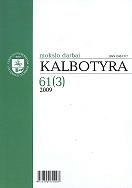PRIEŠPRIEŠOS KONEKTORIŲ VARTOJIMAS BESIMOKANČIŲ ANGLŲ KALBOS IR ANGLAKALBIŲ STUDENTŲ RAŠTO DARBUOSE
CONTRASTIVE CONNECTORS IN ADVANCED LITHUANIAN LEARNERS’ AND NATIVE SPEAKERS’ ENGLISH WRITING
Author(s): Lina BikelienėSubject(s): Language and Literature Studies
Published by: Vilniaus Universiteto Leidykla
Keywords: priešpriešos konektoriai1; besimokančiųjų tekstynai2; LICLE3; LOCNESS4; interkalba5;
Summary/Abstract: This paper shows an attempt to present the analysis of contrastive connectors in advanced Lithuanian learners’ and native speakers’ English writing. For the purpose of the study LICLE corpus (Lithuanian subcorpus of ICLE (International Corpus of Learner English)) was used. A comparison is made with the native speakers’ data obtained from the British segment of LOCNESS (Louvain Corpus of Native English Essays). Several comparisons are made with the American and the A-level segments of LOCNESS as well. The central research questions are (1) whether advanced Lithuanian learners openly mark contrastive relations in the same way to natives and (2) whether text and sentence distribution of contrastive connectors is the same in the corpora under consideration. A special attention is paid to the use of however, which is the most commonly used contrastive connector and occupies the first place among the top ten connectors in the LICLE corpus. The obtained results indicate that though there is no statistically significant difference in the quantitative use of contrastive connectors, their distribution patterns in LICLE to a greater or lesser extent differ from those of the native speakers’. The Lithuanian learners, for example, significantly overuse contrastive connectors in a non-preferred sentence-initial position whereas the native speakers’ preferred sentence-medial position is significantly underused. This tendency is not characteristic only of the Lithuanian learners of English and could be considered a common phenomenon of the interlanguage.
Journal: Kalbotyra
- Issue Year: 2009
- Issue No: 61(3)
- Page Range: 21-35
- Page Count: 15
- Language: Lithuanian

